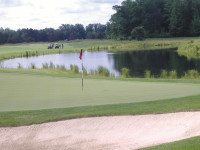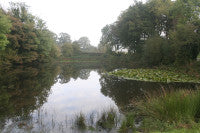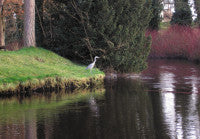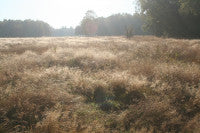Environmental enhancement made simple
 We all know that we need to play a role in protecting our environment. Course Managers are inundated with numerous suggestions to help protect the environment and eco-friendly products and practices with which to do this. It is important to remember that Course Managers, Greenkeepers, Superintendents, call them what you will, are extremely busy people in charge of large tracts of land. So, not every suggestion and environmental hot topic will be included in an already jam packed schedule.
We all know that we need to play a role in protecting our environment. Course Managers are inundated with numerous suggestions to help protect the environment and eco-friendly products and practices with which to do this. It is important to remember that Course Managers, Greenkeepers, Superintendents, call them what you will, are extremely busy people in charge of large tracts of land. So, not every suggestion and environmental hot topic will be included in an already jam packed schedule.
There are, though, a number of simple steps and management practices which will help protect and enhance wildlife and the state of the local environment. And there are a couple of underlying strategies which can help ensure the environment does not get put at the bottom of the list. These fundamental principles can be made applicable to any situation and adapted to suit budget and time available. These include:
Maintain water in good condition and improve water quality.
Basically, maintaining water i.e. ponds, streams, ditch water and wetlands in a healthy state for wildlife (and also the quality of the course). Ensuring chemicals do not enter or drift into the water, or re-thinking any management strategy which causes degradation to the water.
Water is of special importance for diversity and is an essential component of habitats, it also adds greatly to the beauty and uniqueness of the course. Ensuring buffer zones are in place around water features is an important element in protecting the quality of the water. 
These buffer zones not only protect waterbodies but also act as cover and habitat for numerous wildlife species. A buffer can significantly reduce nutrient and sediment runoff entering waters.
Give preference to Native Plants
I believe that native plants have a greater claim to the landscape, support huge numbers of wildlife species and preserve and enhance the local character of the area. Needless to say, when purchasing plants for the course it is best to support locally grown varieties.
 Native plants add to the uniqueness of an area, attract more diversity and are easier to establish and maintain than the more non-native exotic plants which are not indigenous to the area. A variety of native plants which supply berries, seeds and nuts will be very popular with the local wildlife and add to the character of the course.
Native plants add to the uniqueness of an area, attract more diversity and are easier to establish and maintain than the more non-native exotic plants which are not indigenous to the area. A variety of native plants which supply berries, seeds and nuts will be very popular with the local wildlife and add to the character of the course.
Increase the quality of areas left to nature or naturalised areas
Rough and other out-of-play areas are ideal sites for this. Natural areas contribute greatly to the local biodiversity. Maintenance costs will be greatly reduced, as will labour. Also, naturalised areas contribute to aesthetics and interest on the course. Natural areas like tall grasses or wild flowers make a course stand out from others and, at the same time, show golfers that the interest of nature is important to the course.
Add to the horizontal diversity as well as the vertical diversity
Horizontal diversity can be achieved by increasing the different area types on the course like grassy areas, wooded areas, water features, rocky areas and ditches to increase biodiversity. The greater the variety the more opportunities for creating wildlife habitats become available which, at the same time, adds a distinctive charm to a course.
Vertical diversity refers to, for example, having different layers present in a woodland stand i.e. trees of varying ages and heights, thereby ensuring that there is healthy ground, shrub and canopy diversity.
Enhance and improve sensitive areas and degraded areas 
On the course, but additionally the corridors to connect habitats for safe / undetected movement of wildlife species. A corridor refers to the joining up of fragmented habitats with similar characteristics as the habitat itself (again facilitating movement and genetic dispersal). Safe corridors are required to link these isolated pockets of habitats to improve the size and condition of a habitat as well as increase the species number allowed to be supported by the habitat. Restoring any areas which have been degraded due to knock on effects from other management strategies or in the actual building of the course is important. This will help bring back the local character to the course.
Protect wildlife
Erect bird and bat boxes in quiet out-of-play areas on the course. Inform golfers not to disturb animals especially during nesting and breeding. This will help keep wildlife population on the course optimal and will also alert the locals that you are doing your bit to help wildlife in the area, making sure the course has a good image in terms of the local environment. Wildlife usually has a preference to observe us from afar (no matter how good your swing is!) and usually do not like to be observed.
A successful habitat will contain the four fundamental elements, namely space, food, water and shelter. When all these four components are available it  ensures a healthy and diverse wildlife population.
ensures a healthy and diverse wildlife population.
Needless to say, all the above steps need not be implemented at the same time - a gradual implementation will certainly enhance wildlife and the environment on the course. Each individual course is unique in its management strategies and also in the state of particular features. Priority can be given to principles which can be realistically improved in terms of finance, time and labour and built upon over time to achieve tremendous environmental enhancement.
By sticking to the fundamental principles many things can be achieved and improved (and built on in the future):
• Habitats will be improved
• Wildlife population will be improved
• Wildlife activity will be improved
• Aesthetics will be enhanced
• The image of the golf course will be improved
• Maintenance can be reduced
• Chemical use can be reduced
When deciding to implement a strategy plan to improve wildlife and the environment it is important to set realistic goals and work with what is available. Small steps can add greatly to the state of the golf course in terms of nature and environmental development.
About the Author: Mary Purcell is carrying out research for a doctorate degree in Environmental Science at University College Dublin in the School of Architecture, Landscape and Civil Engineering. For more information contact Mary at mary.purcell@ucd.ie
